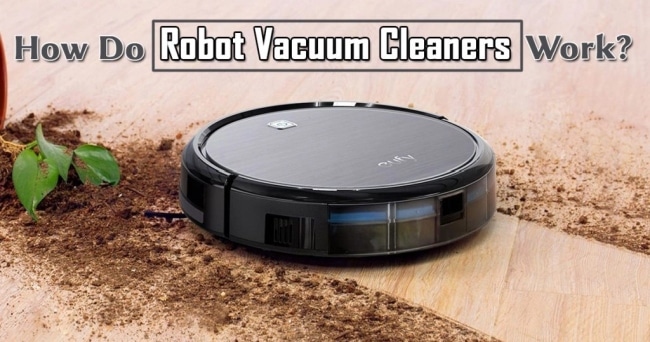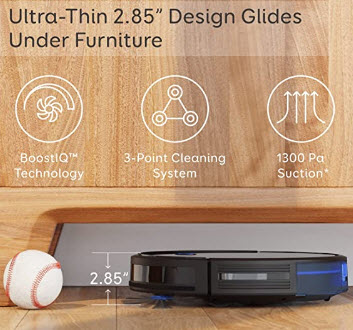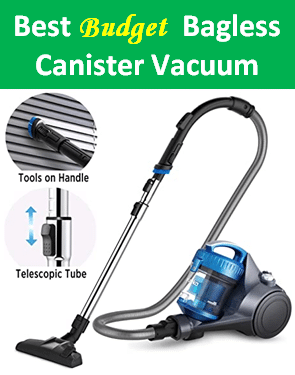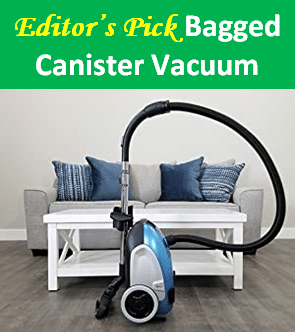Last updated on August 29th, 2022
You maybe wondering: how robot vacuums work? Well, when the first iRobot Roomba hit the market in 2002 and many people was amaze with how the robot vacuums help in their house cleaning.
The popularity of these little cleaning assistants has:
- promoted innovations in new designs and software
- resulted in other robotic cleaning systems like mops
Yet in the past years since that first Roomba, the basic form of the robot vacuum has remained mostly unchanged.

The Vacuum in Robot Vacuum
Similar to the layout of a tricycle, the device rolls on two main wheels with a nose wheel in front that provides balance and steering.
Robot vacuums work with an array of cleaning tools.
A primary roller brush, similar to an upright vacuum, loosens and lifts particles away from the floor. The brush is housed in a suction chamber that sucks all the loosened debris into a dust bin.
These dust bins have HEPA or HEPA-style filters that trap tiny particles and allergens. Running robot vacuums with these features multiple times a week will help filter and clean the air in your home.
Most units also have one or more spinning side brushes for cleaning along walls and other structures.
The combinations of these three cleaning components are often referred to as a “Three-tiered Cleaning System.”
- main brush
- side brush
- vacuum suction
A robot vacuum claiming to have a “Four-step Cleaning System“ usually just means it has two rotating side brushes.
Rounding out the bottom is a battery compartment typically with a rechargeable lithium-ion battery pack.
You’ll also find charging pins. These allow the robot vacuum can easily connect to the charging dock on its own to recharge.
The best selling yet reliable robot vacuum in the market now:
- A very slim Robovac (2.85”) with quiet operation.
- Powerful cleaner with BoostIQ Technology.
- Triple filter system and large 0.6L dustbox.
- Suitable for hard floor, tile, and carpet (low to medium pile).
- Affordable price (below $150 when on sale, grab it now).
The Robot in Robot Vacuum
Sensors are what turn a stationary vacuum into a responsive, self-navigating utility.
They determine when and how a robot vacuum responds to its environment by using simple pre-programmed maneuvers. Manufacturers often keep the details of their navigation systems secret, but they all have a standard group of sensors to help them move safely around a room.
Drop sensors are positioned on the bottom-front of a robot vacuum.
- They bounce infrared light to the floor and back.
- The robot vacuum will stop and change course when it takes longer than normal for this light to bounce back.
- The bot will rotate and move away in another direction.
Wall sensors perform a similar function as cliff sensors but at a 90-degree angle to the floor.
- They allow a robot vacuum to recognize when it is close to walls or and other objects.
- They will then either move parallel to the wall for edge cleaning or navigate elsewhere depending on the setting.
- In a standard cleaning mode they will normally rotate away from the wall.
- In an edge mode the will move along the wall cleaning around the bottom.
Bump sensors do exactly what they sound like they would.
- They register physical contact with objects and respond as programmed.
- The robot vacuum might randomly turn 90 degrees and head off or even do a complete 180 and head back the way it came.
Lastly, optical encoders are sensors that measure the distance the robot vacuum has moved.
- They record the number of rotations the wheels are making.
- It gives the electronics an idea of where the robot is in relation to its charging dock or how far it has travelled since the last sensor made contact.
The Robot Vacuum Cleaning Modes
There are three basic cleaning modes that almost all robot vacuums have.
1. Auto Mode
The robot vacuum moves freely around the entire room. The feedbacks from sensors determine how it responds to surroundings.
2. Spot Mode
The robotic vacuum stays in a small area and moves in a circular cleaning pattern. This can normally be initiated mid-cleaning or manually.
3. Edge Mode
The automatic vacuum uses its wall sensors to sweep along walls and corners.
Robot Vacuums with just the standard features are not typically recommended for thicker rugs and carpets. They can also have trouble navigating in homes with darker carpets and rugs. Sensors bounce infrared light around for navigation and, since darker colors absorb light, they can have a harder time “seeing” in these areas.
So Are Robot Vacuums Smart?
When you watch a robot vacuum going about its work in random directions does it actually know where it’s going? At the very least, they use all of their sensors to navigate as safely as possible around a room. Some pricier models have more advanced navigation and mapping software, with some even uses cameras to map a room.
If you dip a cat’s paws in paint the entire floor will be coated given enough time…and of course paint.
The most basic models follow one simple rule to get the job done. Give them enough time and their brushes will reach almost every square inch of a floor while removing plenty of the pet hair, dirt, allergens, and anything else it picks up along the way.
What About Price and Performance?
A good starting price point is $200. At this price range you’ll find basic devices with solid cleaning performance. They won’t require ear plugs to operate and will navigate well enough that you won’t hear them beeping every ten minutes from getting stuck.
Amazon Best Sellers Robotic Vacuum Cleaners
As with anything else, higher prices don’t always translate to better performance. It pays, or saves, to do your research and consider the needs of your home.
If you have a small studio apartment with bare floors, you might find that a $99 unit is all you need to keep your bare feet from picking up those tiny particles that drive you nuts on an otherwise pleasant day.
Some variations to pay attention to reading product details include:
- Operating Time: 90-140 minutes
- Weight: 4-8 lbs
- Noise: 52-60 db
- Height: 2.5 – 4 inches
Suction strength is measured in Pascal Units (Pa). You don’t see them mentioned in detail sheets often.
If the manufacturer took the time measure and advertise a model’s Pascal Units then they’re probably pretty proud of its performance. Most manufacturers either just don’t take the time do it or don’t believe it’s worth mentioning.
If a robot vacuum is advertised as having “5x more suction power”, or something similar, look for an asterisk next to it. You might find a note indicating that this means it is 5x more suction than the previous model.
The truth is that most robot vacuums provide satisfactory suction considering that this is their main purpose. If you want to make sure you’re getting a one that meets your expectations you can always read the comments from owners to see if they mention suction strength.
For a complete robotic vac buying guide, read here.
And What About the Remote Control?
All robot vacuums have a physical power button and some form of a start button that initiates an automatic cleaning mode. Unlike poking a lazy teenager to wake up and do some chores, a press of the start button on your robot vacuum will bring it to life, unhooking from its charging dock to dutifully begin vacuuming your floor.
Remote controls have these same buttons and others used to control the robot vacuum’s features. Most have manual steering buttons for when your cat knocks over the cereal box you forgot to put away. You can simply grab the remote, steer your robot vacuum over to the mess, and press the spot cleaning button all from the comfort of your couch.
Other buttons might include a return to base option to tell the robot vacuum to return to its dock, a heavy mess button that juices up the motor for more suction strength, and scheduling buttons to use with either an on-remote or on-device LCD display.
As more manufacturers integrate Wi-Fi into their units it can be expected to see the remote control become less vital to robot vacuum control and see smart phone apps take over as the preferred method.
The Recommended Robotic Machines
As there are many manufacturers that producing different models but most of the cleaners are pretty similar in term of functionalities. The following are few of the models that pick by our editors:
1. Best Overall – iRobot Roomba 981 Robot Vacuum
This model is powerful in suction to deliver great pick-up performance. You can expect this model to clean the entire house thoroughly with their technology like sensors, iAdapt navigation, and vSLAM technology. The machine even can listen to your voice to start the cleaning with the help of Google Assistant & Alexa. Also, it’s ideal for homes with pets.
2. Best Seller Model – eufy by Anker, BoostIQ RoboVac 11S (Slim), Robot Vacuum
This is an affordable multi-surface robot cleaner except for high-pile carpets. The machine is very thin and powerful with its BoostIQ Technology. With one charge the machine is able to clean for about 100 minutes to get you a cleaner home. A low noise, triple filter, and large dustbox make this model one of the best seller robot vacs on Amazon.com.
3. Best Affordable Model – ILIFE V3s Pro Robot Vacuum Cleaner
This is an affordable robot vacuum that is good for picking up pet hairs, dirt, and debris on hard floors. The low profile of 3 inches can let the machine clean underneath the sofa, or bed easily. You can schedule the cleaning in advance, and their infrared sensors can ensure safe and smooth cleaning. For normal cleaning, the runtime of up to 100 mins can be expected.
Also read: How Robot Vacuum Cleaner Functions?
Final Words
The robot machine has been getting more and more popular as it offers several benefits if compare it to the traditional vacuums like upright or canister vacuums.
This article already highlights how do robot vacuums work and you should have better understanding on it. If you needs, you can get any one of the recommended models above to help you clean your home.


